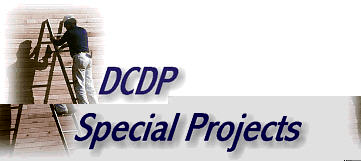
The Community Demonstration Programs Division is involved with a number of Special Program Initiatives which relate to the OCS Mission of moving low income families toward self-sufficiency, and particularly on assistance to those making the transition from Welfare to Work.
We recognize that in most states TANF has succeeded in significantly reducing the welfare roles by helping those with the most job readiness and the fewest personal barriers get jobs; and that States are now faced with reaching the remaining TANF recipients who are the hardest to serve, with the least education and job readiness and the most serious personal barriers, including health, mental health, language, and substance abuse problems. At the same time, we recognize as well that many former TANF recipients now working are employed in jobs that do not pay family-sustaining wages or provide health care and other supportive services that the new workers need if they are to advance on the job and become truly self-sufficient.
Under the Special Projects initiatives the staff is responsible for working with other federal agencies and local communities to oversee the implementation of projects with the following approaches:
The projects involve innovative approaches to building deconstruction and materials re-use; healthy, toxin-free homes and communities; support for non-custodial fathers; work with prisoners and families; post-employment support services for former TANF recipients; careers in Highway Construction for women, minorities, and TANF recipients; sustainable community development; and other initiatives looking toward community development and revitalization.
ECONOMIC DEVELOPMENT AND WELFARE REFORM
There is an emerging issue in Welfare Reform: Will TANF replace welfare with a permanent underclass of working poor whose needs will drain local community resources? Or are we to supplant welfare mothers with working families having pride and hope? What is needed to give these families pride in their work and hope for the future?
First: We must do more than just connect TANF recipients to existing jobs and employers; we must focus on building careers. This will mean building capacity in low-income communities which will lead to a measure of economic control over the engine which creates jobs. We must build vertically integrated local enterprises that will create jobs and career opportunities with family-sustaining wages and fringe benefits and with upward mobility. Enterprises that will reverse the dollar drain from low-income communities and revitalize their economies. Above all, we must not be satisfied in the short term (or at any time) with the jobs at the bottom -- minimum wage or part-time jobs without benefits, performing work which profits absentee owners and which leaves the worker in poverty. Second: We must work to provide the supports and incentives that will make it possible for transitioning welfare clients to succeed in their employment, advance their careers, and achieve genuine and lasting self-sufficiency. We must also work to support fathers so that they can move successfully into family-sustaining careers that can lift their children out of welfare. All this will mean involving employers with local Social Agency support structures, such as the network of 1000 Community Action Agencies, to provide "post employment support services" essential to job retention and advancement. These efforts must recognize that many of those who remain unemployed or underemployed may have developmental or learning disabilities or substance abuse problems that will require special care or training before they can enter the workforce. Finally, we must seek innovative ways, such as the growing practice of establishing and supporting "Individual Development Accounts" -- "IDA's" -- to encourage low income families to invest in assets which will enable them to move into the economic mainstream. Third: We must look to local Community Action Agencies, and other community based organizations for innovative strategies to develop partnerships that can access national and local resources, build local capacities, and overcome barriers, both personal and structural, to success. This must include work with noncustodial fathers to help them become family breadwinners, and, of the utmost importance, strategies that can reduce the rates of incarceration among minority males, and that can help prisoners and their families maintain and strengthen the ties that can reduce recidivism and contribute to family prosperity after release. It must also include assuring that families live in healthy homes in healthy communities, homes that are free of health- and life-threatening toxins such as lead, asbestos, dangerous pesticides and asthma-causing antigens; and homes that are safe and energy efficient without compromising indoor air quality; so that working families will not be burdened with disabling and expensive health problems, with budget busting heating and cooling costs or the risks of improperly vented or dangerous space heaters.
NEW INITIATIVES
Community Action Agencies, other Community-Based Organizations, Foundations, or others with innovative ideas or projects whose goal is to increase the economic, social, and physical viability and health of low-income communities and their residents are encouraged to share them with the staff of the Community Demonstration Programs Division here at OCS.
|
|